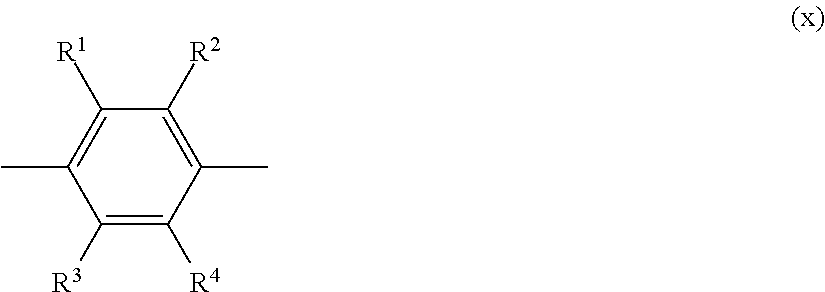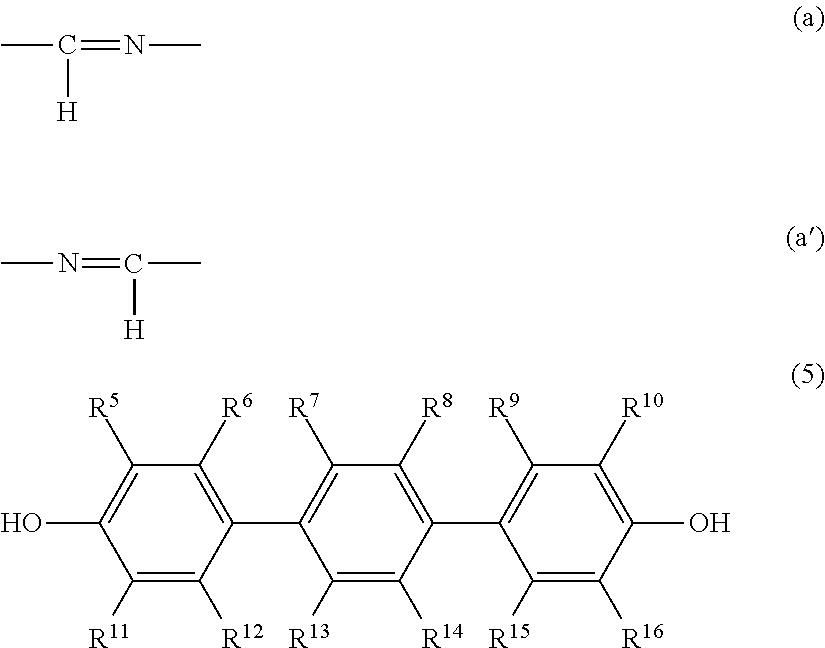Epoxy composition and epoxy resin molded article
- Summary
- Abstract
- Description
- Claims
- Application Information
AI Technical Summary
Benefits of technology
Problems solved by technology
Method used
Image
Examples
example 1
[0072]Terephthalylidene-bis-(4-amino-3-methylphenol) diglycidyl ether (DGETAM, epoxy equivalent: 228) and 4,4″-dihydroxy-3″-methyl-p-terphenyl (DHTP-M, hydroxyl group equivalent: 138) were dissolved in methyl ethyl ketone (MEK) so that the ratio of the number of epoxy groups derived from DGETAM to the number of hydroxyl groups derived from DHTP-M was 1:1 to prepare a solution, and tetraphenylphosphonium tetraphenyl borate was added to the solution so that the ratio thereof to 100 parts by mass of DGETAM was 1 part by mass to prepare an epoxy composition of Example 1.
[0073]This epoxy composition was poured into an aluminum cup, and heated to a temperature of about 100° C., thereby removing the solvent (MEK) to prepare a dried solid.
[0074]Then, this dried solid was kept in a vacuum chamber of 150° C. for 10 minutes in a state where it was placed on a glass plate, thereby performing melt defoaming.
[0075]A spacer was placed on around this glass plate, and another glass plate was further...
example 2
[0078]Terephthalylidene-bis-(4-amino-3-methylphenol) diglycidyl ether (DGETAM, epoxy equivalent: 228) and 4,4′,4″-methylidynetrisphenol (TrisP-PHBA, hydroxyl group equivalent: 97) were dissolved in methyl ethyl ketone (MEK) so that the ratio of the number of epoxy groups derived from DGETAM to the number of hydroxyl groups derived from TrisP-PHBA was 1:1 to prepare a solution, and tetraphenylphosphonium tetraphenyl borate was added to the solution so that the ratio thereof to 100 parts by mass of DGETAM was 1 part by mass to prepare an epoxy composition of Example 2.
[0079]This epoxy composition was poured into an aluminum cup, and heated to a temperature of about 100° C., thereby removing the solvent (MEK) to prepare a dried solid.
[0080]Then, this dried solid was kept in a vacuum chamber of 150° C. for 10 minutes in a state where it was placed on a glass plate, thereby performing melt defoaming.
[0081]A spacer was placed on around this glass plate, and another glass plate was further...
PUM
| Property | Measurement | Unit |
|---|---|---|
| Thermal conductivity | aaaaa | aaaaa |
Abstract
Description
Claims
Application Information
 Login to View More
Login to View More - R&D
- Intellectual Property
- Life Sciences
- Materials
- Tech Scout
- Unparalleled Data Quality
- Higher Quality Content
- 60% Fewer Hallucinations
Browse by: Latest US Patents, China's latest patents, Technical Efficacy Thesaurus, Application Domain, Technology Topic, Popular Technical Reports.
© 2025 PatSnap. All rights reserved.Legal|Privacy policy|Modern Slavery Act Transparency Statement|Sitemap|About US| Contact US: help@patsnap.com



